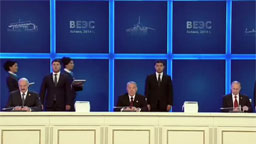Tuesday 10 March 2015
Nazarbayev, Putin and Lukashenko to Meet in Astana on March 13
Keywords:
ASTANA (Interfax-Kazakhstan) – Kazakh President Nursultan Nazarbayev and his counterparts from Russia and Belarus, Vladimir Putin and Alexander Lukashenko, will be meeting in Astana on March 13, the press office of the Kazakh president says in a press release.

- The signing ceremony of the Treaty on the Eurasian Economic Union (Astana, 29 May 2014)
The three presidents will discuss prospects of trading and economic cooperation between their countries, tendencies in the global economy as well as the situation in Ukraine, the press release says.
Last May, the leaders of Russia, Kazakhstan, and Belarus have signed a treaty in Astana on the creation of a Russian-led Eurasian Economic Union (EEU). The accord formally created a territory for unified customs tariffs beginning on January 1, 2015. Armenia’s accession came into force on 2 January 2015. Although Kyrgyzstan’s accession will not come into force until May 2015, provided it has been ratified, it will participate in the EEU from the day of its establishment as an acceding state.
The EEU has sought to base its model on the European Union. Important decisions for the EEU are addressed by the Supreme Eurasian Economic Council, which is composed of the Heads of State of the Member States. The Supreme Council determines the strategy, direction and prospects of integration and takes decisions aimed at achieving the goals of the union.
The Eurasian Economic Commission carries out its work in compliance with the Treaty on the Eurasian Economic Commission (EEC) and the international agreements that provide the legal and regulatory framework of the Customs Union and the Single Economic Space.
The EEU is an extension of the Customs Union of Belarus, Kazakhstan, and Russia which came into existence on January 1, 2010. The Customs Union’s priorities were the elimination of intra-bloc tariffs, establishing a common external tariff policy and the elimination of non-tariff barriers. It was launched as a first step towards forming a broader single market inspired by the European Union, though not aiming at a political integration with the objective of forming an alliance between former Soviet states. The member states planned to continue with economic integration and were set to remove all customs borders between each other after July 2011.

